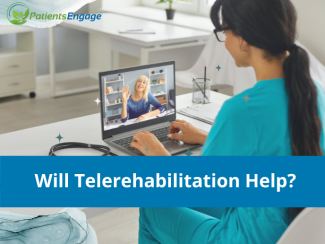
Over 300 million people all over the world are affected by low vision. Low vision not only compromises daily living but also impairs quality of life. Ms Beula Christy, PhD, Head, at Institute for Vision Rehabilitation, L V Prasad Eye Institute explains the concept of telerehabilitation and when it is helpful.
What is visual telerehabilitation?
Visual telerehabilitation refers to a collection of telehealth services designed to provide remote rehabilitation for individuals with visual impairments. This is usually accomplished through methods like videoconferencing and other visual communication tools. The main focus of visual telerehabilitation is to offer interventions that address issues relating to impact of vision loss. This begins with providing counseling and guidance to support psychological well-being. The activities within visual telerehabilitation can encompass a variety of approaches. This may include counseling sessions to address emotional well-being, training sessions to improve visual skills, and potentially even incorporating family members to enhance the rehabilitation process. visual telerehabilitation serves as a means to extend healthcare services to individuals who might otherwise encounter barriers to access. By utilizing technology to overcome geographical limitations, this approach ensures that patients receive the required support and interventions, thereby enhancing their overall quality of life.
What is the disease burden of low-vision in India?
Globally, 253 million people have visual impairments. The prevalence of visual impairment in India is 56 million, with 8 million individuals experiencing blindness and 48 million individuals having low vision. Collectively, this accounts for 37% of the global population with visual impairments.
Is there a growing interest in telemedicine? Is it practical for our rural population?
In my perspective, the interest in telemedicine is undeniably on the rise, and its practicality for our rural population is a matter worth considering. The numerous advantages it brings, such as the ability to stay connected with healthcare professionals, the convenience of receiving therapy in familiar environments while being in the comfort of one's own space, the reduction in travel expenses, and various other benefits, have generated a considerable level of interest and curiosity.
Looking towards the future, tele-rehabilitation holds immense potential in the context of digital India. However, it is important to acknowledge that at present, accessibility remains restricted to a limited number of individuals. Factors like inadequate internet connectivity, the lack of skills and awareness among parents or family members regarding the use of technological devices, and the affordability of purchasing such gadgets contribute to these limitations.
To fully realize the benefits of telemedicine, it is crucial to address these existing barriers and ensure a more widespread availability and impact, especially within rural communities. By actively working to bridge the gaps in technology, education, and affordability, we can unlock the true potential of telemedicine and its transformative power in providing healthcare services to individuals in even the most remote areas.
How is it compared (good and bad) to in-office rehab?
When comparing center-based and tele-rehabilitation interventions, each approach presents its own merits and demerits. Center-based interventions offer a broad range of advantages, such as access to a variety of specialized equipment that may not be feasible for individuals to acquire independently. Additionally, direct training from qualified therapists is available, which is particularly important when dealing with complex cases involving young children with multiple disabilities. However, a key limitation of center-based services is the constraint of time, often due to lengthy travel durations that can outweigh the actual therapy session. This can lead to fatigue and stress, especially in cases where public transportation is involved. Moreover, the cost associated with travel and therapy sessions can become a significant financial burden.
On the other hand, tele-rehabilitation brings its own set of benefits. It offers convenience and eliminates the need for travel, allowing therapy to take place within the comfort of the patient's home. This is especially valuable for individuals who face accessibility challenges or reside in remote areas. However, tele-rehabilitation relies heavily on the support and involvement of family members, and the effectiveness largely depends on their commitment and ability to implement therapy techniques correctly.
Considering these aspects, a combination of center-based and tele-rehabilitation interventions seems to offer the best of both worlds. Starting with center-based interventions can provide access to essential specialized equipment and direct therapist guidance. Once a solid foundation is established, transitioning to tele-rehabilitation follow-up sessions at home can maintain progress and continuity. This model would alleviate travel-related stress and costs while capitalizing on the convenience of in-home sessions. The success of such a model would hinge on comprehensive training of family members and caregivers, ensuring they are equipped to support the therapy process effectively.
Who can benefit from telerehab? What are the challenges that prevent people from availing office-based rehabilitation?
Telerehabilitation extends its benefits to a wide range of individuals, encompassing those with vision loss, along with their family members, professionals, and community members who are eager to support those with visual impairments.
When it comes to the challenges that hinder individuals from accessing center-based rehabilitation, several factors come into play. Time constraints often make it difficult for individuals to incorporate center-based sessions into their schedules. The direct and indirect costs associated with therapy, along with the absence of nearby training centers, contribute to these challenges. The lack of a companion to facilitate transportation poses another obstacle, and physical strain as well as accessibility concerns, especially for those who rely on public transportation, further compound the difficulties. Collectively, these elements create barriers that undermine the practicality of pursuing center-based rehabilitation.
In which situations is telerehab applicable?
Telerehabilitation proves to be applicable in various scenarios where the continuity of services faces disruption. This includes instances of public pandemics such as Covid, periods of physical constraints due to illness, challenges posed by aging, and situations involving young children under medical care who are unable to travel. Telerehabilitation is well-suited for individuals whose training and therapy can be effectively managed within the comfort of their homes with the assistance of family members.
What does a patient need for telerehab?
The necessities can differ depending on the individual's circumstances. However, in general, patients would require a device capable of connecting them with the rehab counselor. This can include telephones, smartphones, tablets, and personal computers equipped with internet connectivity.
How many sessions are needed? How long is each session?
The number of sessions needed varies significantly based on individual requirements. It is contingent upon factors such as the person's specific training needs, their learning capabilities, the extent of support they receive from their family members, and the type of training being provided. For instance, acquiring skills like braille proficiency or the use of assistive software might typically span around 3 months, with the potential for eventual conclusion. However, interventions for children with multiple disabilities often necessitate a long-term approach that could extend over months or even years. As for the duration of each session, it is recommended to allocate 30 to 45 minutes. Beyond this timeframe, maintaining engagement and focus during the session becomes increasingly challenging.
How is visual function measured online for new and continuing patients?
Tele-rehabilitation is highly recommended as a follow-up to center-based services. The initial evaluation should take place at the center, where visual functions are clinically measured and assessed through informal methods. While teleconsultations can be used for informal progress assessments conducted through parents, recording visual functions is best done at the center during follow-up visits. This is why a combined approach involving both center-based services and tele-rehabilitation is essential, with at least one visit to the center per quarter being recommended.
What issues do you face with compliance?
A range of difficulties arises in this aspect. These include issues concerning internet connectivity, instances where services are not accessible as per the schedule, and parents facing challenges in effectively managing devices. Additionally, there's the aspect of maintaining clients' engagement and interest, managing the physical strain on therapists who need to provide comprehensive explanations and guide parents through interventions, and addressing background noise – all of which are common challenges that arise.
Does it address social and psychological well-being of the patient, as it may go hand-in-hand with quality of life?
Absolutely, this aspect has been evident, especially during the Covid pandemic. Staying connected with therapists, even through simple phone calls, has been instrumental in boosting their confidence
When patients are hiring a telerehabilitation specialist, what should they be looking for? (language/counselling skills etc.)
To begin with, users seeking tele-rehabilitation consultation should ensure that their specific needs are clearly communicated and understood. They should feel confident that they have found the right type of counselor or therapist who can effectively address their individual requirements. This includes factors such as language familiarity and the assurance that the therapist will handle personal information with the utmost confidentiality.
Additionally, users need to be prepared for potential limitations in virtual consultations, such as issues with voice clarity, internet connectivity, limited availability of time, and the absence of hands-on experience. I highly recommend at least one in-person consultation with the therapist or counselor before commencing tele-rehabilitation for follow-up sessions. This helps establish a stronger foundation for the tele-rehabilitation process.
Contributed by Ms. Beula Christy, PhD, Head, Institute for Vision Rehabilitation L V Prasad Eye Institute








